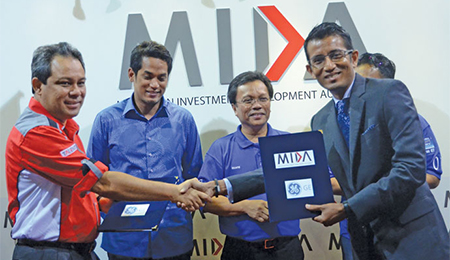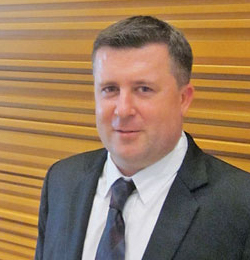One is a global pioneer in semiconductor research and manufacturing. Another comes from the world’s most famous watch-making valley in Switzerland, and makes testing equipment for those semiconductor makers.
The two companies — Intel and Ismeca, part of the Swiss Cohu Group — have something in common besides precision. They know precisely how well Malaysia works for them when it comes to regional operations.
Since its inception as a manufacturing site in 1972, with an initial workforce of only 100 employees, Intel Malaysia has evolved into a world-class, fully integrated key assembly and test site with capabilities in assembly technology development of Intel Corporation’s most advanced microprocessors, including the latest 22-nanometer processor. It is Intel Corporation’s largest and most diverse site outside of the United States, with multiple campuses across Penang and Kulim, Kedah.
“Whilst in many countries Intel Corporation has commenced its operation through the set-up of a Sales office, its approach in Malaysia has been different from day one,” says Robin Martin, Managing Director of Intel Malaysia. “The manufacturing operations in Penang continue to be a huge driver of Intel Malaysia’s presence and continuity in the country. In 1995, Intel Malaysia set up its sales and marketing operations in Kuala Lumpur. The assembly test and manufacturing [ATM] operations in Kulim, Kedah was subsequently established in 1996.”
Today, says Martin, it is a world-class site that supports Intel’s various platform challenges. This includes its role as one of Intel’s largest ATM facilities, contributing significantly to Intel’s high volume manufacturing. But like an economic developer’s dream come true, Intel Malaysia also plays a strategic role in global operations, including contributions to the worldwide Design and Development team.
“There are two design centers in Malaysia under the Intel Architecture Group,” Martin explains, “a Chip Design Center in Penang and a Board Design Center in Kulim. These establishments offer advanced and integrated design and development work, along with the full spectrum of development capabilities for SoC [System-on-a-Chip] covering architectural design, pre- and post-silicon validations to market enabling activities for embedded markets.”
Intel Malaysia is also the hub for shared services —particularly in IT and Human Resources — for Intel Corporation worldwide.
In sum, Intel’s investment in Malaysia has grown to more than RM14 billion (US$4 billion) over the past 40 years. Intel Malaysia now employs more than 9,000 highly skilled Malaysians, says Martin, with annual revenue contributing nearly 1 percent of Malaysian GDP. And it supports a broad product range, with over 4 billion microchips produced to date.
It Begins and Ends with Talent
Martin reiterates: The company employs 9,000 people in Malaysia alone. It is the largest offshore site for Intel. “And these 9,000 are all Malaysians.

Robin Martin, Managing Director, Intel Malaysia
“We have programs like the international local hire program; training and development programs; cutting-edge assignments and job rotation opportunities to help retain staff,” he says. “We strive to ensure a competitive compensation and benefits package and provide a variety of services and programs on site to ensure the environment is a great place to work in.”
In addition to government incentives for the electronics and semiconductor industries, says Martin, the availability of educated work force in Malaysia (in terms of both technical skills and language) has been a big reason Intel has maintained a strategic presence there for four decades. But as any global corporation can attest, filling that talent pipeline is a never-ending quest.
“We continue to search for the right talent,” he says. “We have even engaged overseas Malaysian professionals, and try to relocate them to Malaysia. In that respect, we also do our part to develop local talent through industry training programs as the competition for jobs and talent is becoming more intense. The growing mobility of today’s talent pool makes it more challenging.”
So his team has been working very closely with TalentCorp “to bring about positive changes, to attract home talented Malaysians and other professionals to Malaysia through easy securing of work permits, lower tax rates, extending their duration of stay and even possibly providing residency for desired talent to remain in Malaysia for a longer term.”
TalentCorp, established just two years ago, is one of many resources the Malaysian government makes available to companies establishing and growing their regional presence in the country. Collaborating closely with relevant government agencies such as the Malaysian Investment Development Authority (MIDA) and employers in priority economic sectors, TalentCorp develops demand-driven initiatives focused on three strategic thrusts: (1) optimize Malaysian talent, (2) attract and facilitate global talent and (3) build networks of top talent.
A recent job fair it held at the Universiti Malaysia Pahang drew 2,000 engineering and technical students. Another event was held that same day in Sydney, Australia. TalentCorp’s work is in line with the Malaysian Education Ministry’s goal of seeing 80 percent of graduates employed within six months of graduation

Intel’s presence in Malaysia has stretched well beyond manufacturing over the past 40 years.
Intel photos courtesy of Intel Corp.

(Left) Dato’ Azman Mahmud, Deputy CEO, MIDA, exchanging MOU with (Right) Mr. Azli Mohamed, Director of Growth Initiatives and Key Account, General Electric ASEAN based in Malaysia during the BN Youth Job Fair 2013 in Kuala Lumpur. This is part of MIDA’s engagement with various stakeholders to meet talent supply chain requirements of the industries in Malaysia.
‘Where the Action Is’
Datuk Noharuddin Nordin, CEO of MIDA, continues to be amazed — though not surprised — at the ability of the young Malaysian work force to come up with creative and innovative ideas, whether at Intel or other multinational companies. And their creativity can be brought to bear across an entire range of corporate functions as a company builds up a regional presence.
“The challenge for us is to retain that talent in Malaysia,” he says, when a lower starting wage and global exchange rates can sometimes work against that goal. That’s why TalentCorp was created, he says. And it’s why MIDA devotes so much focus to the most promising and innovative global industries.
“Young people want to be where the action is,” he says. “We can help there, by bringing in the right kind of companies to Malaysia and being very selective.”
Meanwhile, the nation offers incentives for talent as well as employers.
“They can bring back a car tax-free, and can enjoy a lower income tax for a period of time,” says Datuk Noharuddin. “And for the foreign talent, we give long-term passes, so they can come in and out very easily.”

MIDA CEO Datuk
Noharuddin Nordin
Indeed, says Hamidah Naziadin, head of corporate resources at CIMB Group, in a testimonial on the TalentCorp website, “TalentCorp as the one-stop-center for the 10-year Residence Pass-Talent (RP-T) since April 2011 has also facilitated the processing of these passes for our top foreign talent at CIMB. Such initiatives increase the attractiveness of Malaysia as a career destination.”
The attraction of increasingly higher-value activities will take care of the salary levels, notes Datuk Noharuddin. Meanwhile, he says, “There is no shortage of talent in Malaysia, because we have so many training and education institutions. And we have a special division dedicated purely to assisting investors in improving and sourcing talent.
Another TalentCorp testimony attests to that:
“We have embarked on a drive to build a sustainable talent pipeline for high-value-added jobs at Altera Corp.,” says Datuk Dr. Mohd Sofi Osman, vice-president APAC region, worldwide operations and engineering, for Altera. “Through various TalentCorp initiatives like the Scholarship Talent Attraction and Retention (STAR) program, the upskilling program FasTrack, the High Income Talent Research Scientist Engineer program (HIT-RSE) and Structured Internships for undergraduates, we are confident of attracting bright Malaysian engineers to high value-added careers in the Electrical and Electronics sector.”
The Measure of a Region
In drawing circles around locations during site selection analysis or corporate strategizing, it can be easy to lump certain areas under the same old labels. But sometimes it takes putting yourself in one of those locations to see firsthand just how many market, talent and supply chain nodes can truly be reached.
“When we say ‘regional,’ we are referring to Asia, but not necessarily just East Asia,” says MIDA’s Datuk Noharuddin. “In the context of Malaysia, it includes the Middle East, which some call West Asia.”
Asked if he’s finding more companies seeking to layer such operations as shared services, headquarters, back-office and R&D in one location, he says, “That is exactly what is happening in Malaysia. Companies that came to do manufacturing, assembly and testing have developed huge campuses.”
Helping that process is the trend by many companies to cut costs by using existing campuses for multiple purposes. Datuk Noharuddin says his country’s environment is very conducive for that.

“Given the continued support of the government and MIDA, I expect Cohu SEG to continue to invest in Malaysia and that we could see our operations triple in size over the course of the next few years.”
— Laurent Zanchi, Managing Director, Ismeca Malaysia, a Cohu Semiconductor Equipment Group company
“The amenities are there, the connectivity is there,” he says. “And on top of that the Malaysian government is willing to constantly review their policies to accommodate the evolving business trend. Some companies initially came to Malaysia as a manufacturing entity, and after 20 or 30 years, they aren’t doing any manufacturing at all. The challenge for us is to make sure our policies and regulations follow suit to accommodate those changes.”
France’s Alstom stands as a strong example. Its point of entry into Malaysia in the late 1960s was selling steam turbines and generators to a power company. Over the years the corporation established a customer service regional headquarters for Northeast and Southeast Asia, receiving Operational Headquarters status from the Malaysian government not long thereafter.
Soon came a field service regional unit, followed by various sales, service and maintenance units serving Asia Pac, East Asia, Oceania or all of the above.
In late 2012 GlaxoSmithKline (GSK) announced the opening of its global shared service hub called Business Service Centre (BSC) in Kuala Lumpur. It will be the only BSC in the Asian region, consolidating global and regional service delivery in IT, Finance, Employee Services, Indirect Procurement and Worldwide Real Estate and Facilities into an integrated shared service network.
A variety of incentives are available to corporate regional establishments, a general category which includes Operational Headquarters (OHQs), International Procurement Centers (IPCs), Regional Distribution Centers (RDCs), Regional Offices (ROs) and Representative Offices (REs).
Is the building stock still there to serve regional establishments?
“Yes, it is,” says Datuk Noharuddin. “For those who have not been to Malaysia, most of them would be pleasantly surprised by the infrastructure and amenities not just in Kuala Lumpur, but in the smaller cities as well.”
Here to Stay
Laurent Zanchi, Managing Director, Cohu Semiconductor Equipment Group (SEG) Malaysia, says support from MIDA has been “unbelievable and unforgettable” as the company decided to grow its Asia operations at either an existing location in the Philippines or in Melaka, Malaysia, where Ismeca, acquired by Cohu on December 31, 2012, established an operations center in 2010. Malaysia’s strategic location as a technology hub had originally attracted Ismeca to invest in a factory in Melaka in 1996. Cohu is the global leader in semiconductor test handling and finishing equipment.
Zanchi compliments not just MIDA’s internal processes, but more importantly, having “the competency to understand what we want and what we want to develop or expand in Malaysia. MIDA has a very friendly investment approach. We received a number of tax incentives, as well as a customized package. And it’s very fast. In certain countries, it would take months and months just to get access to the people.”
Zanchi says the country’s logistics advantages for regional establishments include licensed manufacturing warehouse facilities (which carry the advantages of an import tax waiver and speed); efficient customs handling procedures; proximity to quality suppliers of electro-mechanical systems; good airport and port facilities; competitive costs; and easy access to Malaysia for travelers.
Helping make the business case for continued growth, he says, is a strong customer presence in Malaysia and nearby countries; good English language proficiency (“better than me,” says the native Frenchman); excellent infrastructure; and a qualified supply chain, which he calls “a key decision factor in support of Malaysia, along with competitive human capital and talent.”
Cohu plans to expand the Melaka operation to include volume manufacturing of pick and place and gravity feed handlers.
“Given the continued support of the government and MIDA, I expect Cohu SEG to continue to invest in Malaysia and that we could see our operations triple in size over the course of the next few years. We are just getting started.”
Intel’s Robin Martin can only concur.
“Malaysia continues to be an important focus for Intel’s global operations,” he says, “as it continues to move up the value chain to play an increasingly important role in contributing towards the development of new technologies at Intel.”
This Investment Profile was prepared under the auspices of the Malaysian Investment Development Authority. For more information, visit www.mida.gov.my.
